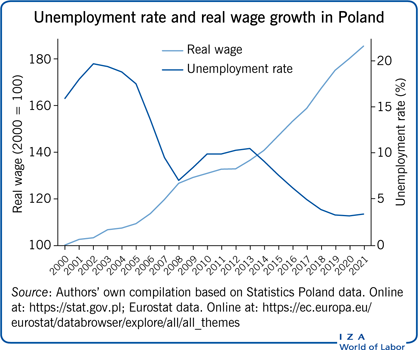Elevator pitch
In the early 2000s, Poland's unemployment rate reached 20%. That is now a distant memory, as employment has increased noticeably and the unemployment rate had dropped to 3.4% in 2021. The labor force participation of older workers increased following reforms aimed at prolonging careers. However, participation remains low compared to most developed countries and the reversal of the statutory retirement age in 2017 leaves Poland vulnerable to the effects of population aging. Rising immigration has eased the resulting labor shortages, but women, people with disabilities, and agricultural workers remain underemployed. During the Covid-19 pandemic the slowdown in economic growth and increase in unemployment were small.

Key findings
Pros
The employment rate for people aged 15–64 increased significantly between 2000 and 2021, while the unemployment rate declined noticeably over the same period; long-term unemployment dropped from 10% in 2003 to 0.6% in 2021.
In 2021, the labor force participation of older workers reached its highest level since the 1990s.
Real wages increased by 87% between 2000 and 2021.
Real wage growth was the highest at the bottom of the wage distribution, and earnings inequality has decreased in the last two decades.
In 2012–2016, Poland had the highest share of temporary employment in the EU, but it has decreased since then.
Cons
Labor force participation of older workers remains low compared to most developed countries; the reduction of the retirement age in 2017 exacerbates the decline in labor supply resulting from population aging.
The adjusted gender pay gap remains high.
The total compensation of employees as a share of GDP is among the lowest in the EU.
The share of agricultural employment remains high.
Lack of a migration strategy hampers the impact of immigration on labor shortages.